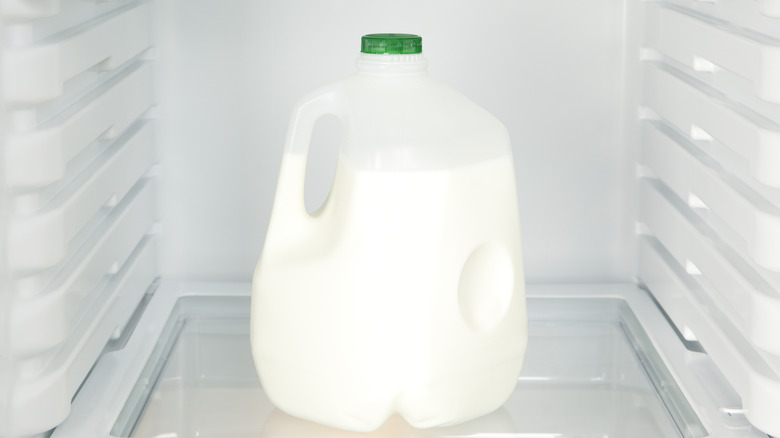The Reason Why Milk Jugs Have Dimples
Have you noticed the circular indentation in the plastic of a milk jug and wondered if it has a purpose? You aren't the only one. Some social media users on Facebook and Reddit speculated that it's meant for pressure control if the milk freezes and expands. However, the purpose of the container dimple is much more important.
Most milk jugs are made with high-density polyethylene (HDPE), which contains the properties of polyethylene as its base with increased density for a strong structure. Combined with the octagonal shape of the container, the circular, concave indent on the side of a milk container increases the stability of the plastic, allowing the internal pressure to disperse evenly. This improved structural support also allows jug manufacturers to reduce the amount of resin needed to make each container. Basically, the containers can be thinner while maintaining an attractive appearance because the dimple prevents the sidewalls from bulging. Since billions of gallons of milk are sold in the United States every year, using less resin adds up to big savings.
On top of that, the indentation allows the manufacturer to precisely control the volume that the jug can hold. This oversight is necessary because the HDPE shrinks over time, more so in hot temperatures, during transport, or long-term storage, similar to how plastic bottles contract during cold weather. The container could appear underfilled if it's too big but overfilled and overflowing if it shrinks too much.
Does a bulging milk jug dimple mean your milk is expired?
In multiple posts across Reddit and Facebook, several users commented that they believed the concave area on a milk jug is there as an indication that the milk has spoiled. The idea is that the bacteria in milk generate gas when they ferment. As that gas builds up in the container, it makes the indentation bulge out, signifying that the milk has gone bad.
However, this theory has been debunked by Pennsylvania State University professor and head of food science Bob Roberts in an interview with USA Today. Although lactic acid fermentation is triggered by various bacteria that survive pasteurization, these bacteria don't generally produce the gaseous pressure needed to push out the indentation. "It (the jug expanding because of bacterial activity) could happen, but most likely if the milk is temperature-abused, I mean really temperature-abused," he explained. "At refrigeration temperatures, you're not going to know your milk is old because the indent pops out."
Despite that, Dairy Management Inc. vice president of product research and food safety Tim Stubbs told the news outlet that a bulging container could happen if the milk is well beyond its expiration. He noted that it's also possible if the milk is cross-contaminated after being opened.

